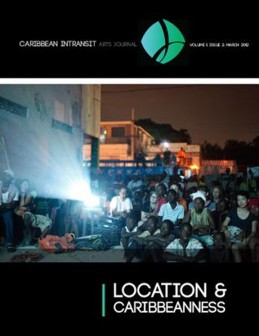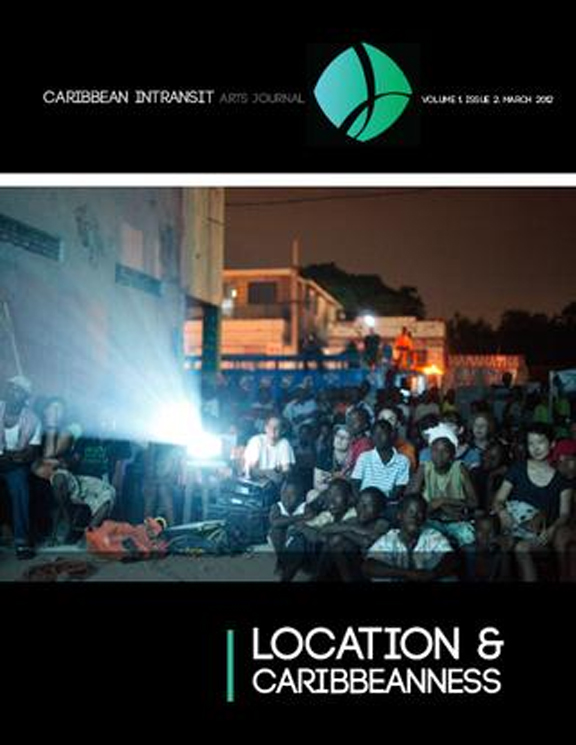By Marlise Andrews
Think of a space where Caribbean artists meet to share and interact. Think of a platform where art can be aired across a wide and diverse audience; a location connecting academia to artistic work and other artists across the Caribbean region. Thanks to Marielle Barrow and her team, the Caribbean Intransit Journal is one such space where, according to Katherine Miranda, the Hispanophone specialist with this new journal Caribbean Intransit, ‘artists can work consciously across linguistic national and cultural traditions to trace a collective sense of Caribbean experience.’ Since its launch in November last year, Caribbean Intransit has addressed a specific need by creating a platform for Caribbean art. Its focus is not only the visual artists but performance, literary, culinary, architectural designers and filmmakers also receive equal acclaim.
 Barrow reveals that the journal is the second stage of a movement that began in 2005 with the Caribbean Arts Village, based in Trinidad. This was a venture focused on promoting artists from around the Caribbean region by providing a community focal point. The journal is an extension of this idea. ‘It is a creative meeting place,’ she reveals. ‘Our methodology enables a mirroring of what esteemed artist and scholar, Rex Nettleford, describes as inward stretch, outer reach.’ The founding team has certainly envisioned Caribbean Intransit as a space where Caribbean art and artists are given incomparable regional and international exposure through an academically rigorous platform.
Barrow reveals that the journal is the second stage of a movement that began in 2005 with the Caribbean Arts Village, based in Trinidad. This was a venture focused on promoting artists from around the Caribbean region by providing a community focal point. The journal is an extension of this idea. ‘It is a creative meeting place,’ she reveals. ‘Our methodology enables a mirroring of what esteemed artist and scholar, Rex Nettleford, describes as inward stretch, outer reach.’ The founding team has certainly envisioned Caribbean Intransit as a space where Caribbean art and artists are given incomparable regional and international exposure through an academically rigorous platform.
The Caribbean Intransit Journal is certainly an ambitious and necessary step in cultivating a unique and cohesive sense of identity within the region. It is the first open access multi-lingual journal focused on the Caribbean arts to be launched, which is concerned with cultivating a sense of community among artists, irrespective of language. ‘Our vision,’ says Barrow, ‘is to foster a community of research and entrepreneurship related to artistic endeavors emerging from Caribbean cultural expressions of identity.’ It is a unifying space that does not alienate in terms of language, but aims to create a fresh way of communicating where the barriers of language are lessened.
The journal, which is published bi-annually in the spring and autumn months, focuses each issue around specific themes. The first issue, launched in Jamaica last year, was guest edited by senior Lecturer at the University of the West Indies, St. Augustine Campus, Patricia Mohammed and entitled, The Politics of the Visual and Vocal. It included pieces as varied as the article written by Alexis Pauline Gumbs on the work of Trinidadian born Canadian poet Dionne Brand, which focused on notions of diaspora, while Pascuale De Souza explored the apparent ambivalence of Guadeloupian identity within a Caribbean context and how this conflicts with the sense of being French. Brian McLoughlin’s contribution, an analysis of L’art primitive of American artist Michel Basquiat (of Haitian and Puerto Rican heritage), was written entirely in French.

The second issue, Location and Caribbeanness, was launched in March this year and was guest edited by Honor Ford-Smith, previously the Artistic Director of Sistren Theatre Collective and currently Associate Professor in the Faculty of Environmental Studies at York University in Toronto. This issue looked at the work of Trinidadian filmmaker, Yao Ramesar and especially his critically acclaimed, Sista God, while performance artist Camille Turner wrote an investigative piece about black identity in Canada. She explored perceptions of being Canadian through a character she created that she called Miss Canadiana, a black beauty queen. Marsha Pearce looked at the significance of J’ouvert, what some people refer to as the soul of Carnival and the start of its festivities, through the art of Trinidadian performers, 3 Canal.
Producing an issue of the Caribbean Intransit journal is a year-round effort. The third issue, Arts for social change, will be published in November this year while the call for papers for the following issue themed, Cutting Edges: New Media and Creative Entrepreneurship, is currently out. The description of Cutting Edges states: Throughout the Caribbean region and its multiple Diasporas, artistic form and practice are at risk. Since the beginning of a global economic crisis in 2008, the arts have been particularly impacted through severe losses of funding and institutional support. These ongoing global challenges to the practice and production of the arts affect the Caribbean in specific ways. Mobilizing the crisis as a critical point of departure, this volume of Caribbean Intransit seeks to examine both the inherent risks and possibilities of the intersection of new technologies, entrepreneurship and artistic practice. How might we deploy the cutting edges of artistry, technological innovation and business practices to find creative solutions to these challenges? How have entrepreneurship, electronic and digital networks, mobilities and artistic projects threatened or empowered the arts in times of crisis? Are indigenous or traditional practices at risk in the age of global communication and exchange? How can experiments in new media, performance, film, literature, music, art, and architecture articulate financially sustainable aesthetic interventions in the contemporary moment?
In keeping with its multi-lingual, multi-dimensional approach, papers are welcomed in English, Spanish or French. Artwork, music, dance, poetry, mas or junkanoo designs or any other artistic expression with blurbs in English, French, Spanish, Dutch, dialect or creole are welcome as well as films in any language with subtitles in English. Fiction or non-fiction writings in English or dialects will be accepted.
Also in the pipeline is a new book entitled, Glocal Archipelago: Art, Location and the Caribbean, being published in collaboration with the Caribbean Studies Press in Miami. ‘Glocal’ is a portmanteau word fusing the ideas behind globalisation and localisation, which calls for communities and regions to think globally and act locally, ideas which are important for the development of art in the Caribbean region, and inherent in the ethos of the journal.
Caribbean InTransit also hosts events in collaboration with various institutions and groups. The most recent “Biennials and Art Practices of the Caribbean” brought a wide array of experiences, projects and concerns into focus. The event was hosted by Caribbean InTransit in partnership with the Smithsonian Center for Folklife and Cultural Heritage (CFCH) on June 28th 2012 at the CFCH. Curators from the Smithsonian, Lecturers, the Ambassador of Trinidad and Tobago to the USA, students and artists were among the presenters and moderators.
It is evident that Barrow and the publishing team she is part of have hit upon something significant with their conceptualization and launch of this journal. It is clear, too, that they have no intention of sitting still. Just like the shifting and fluid and malleable nature of Caribbean identity, so too does this journal introduce dynamism to this debate through the exploration of the art of the region. Artists are the diarists of our time. They serve an important role in detailing our days and writing our history. It is to their work that future generations will turn in an attempt to understand the history of this place, its people and their culture. As Marsha Pearse, one of the collaborators behind this journal revealed, ‘Caribbean Intransit is a bold nexus of the arts and the Caribbean. It promotes the notion of the Caribbean as being ever-shifting; a process of perpetual moving towards.’ It is the goal of Caribbean Intransit to facilitate or even hasten this movement.
For more information about Caribbean Intransit, and to see past and current journal issues, see: http://caribbeanintransit.com/
Current issue of Caribbean Intransit Journal

